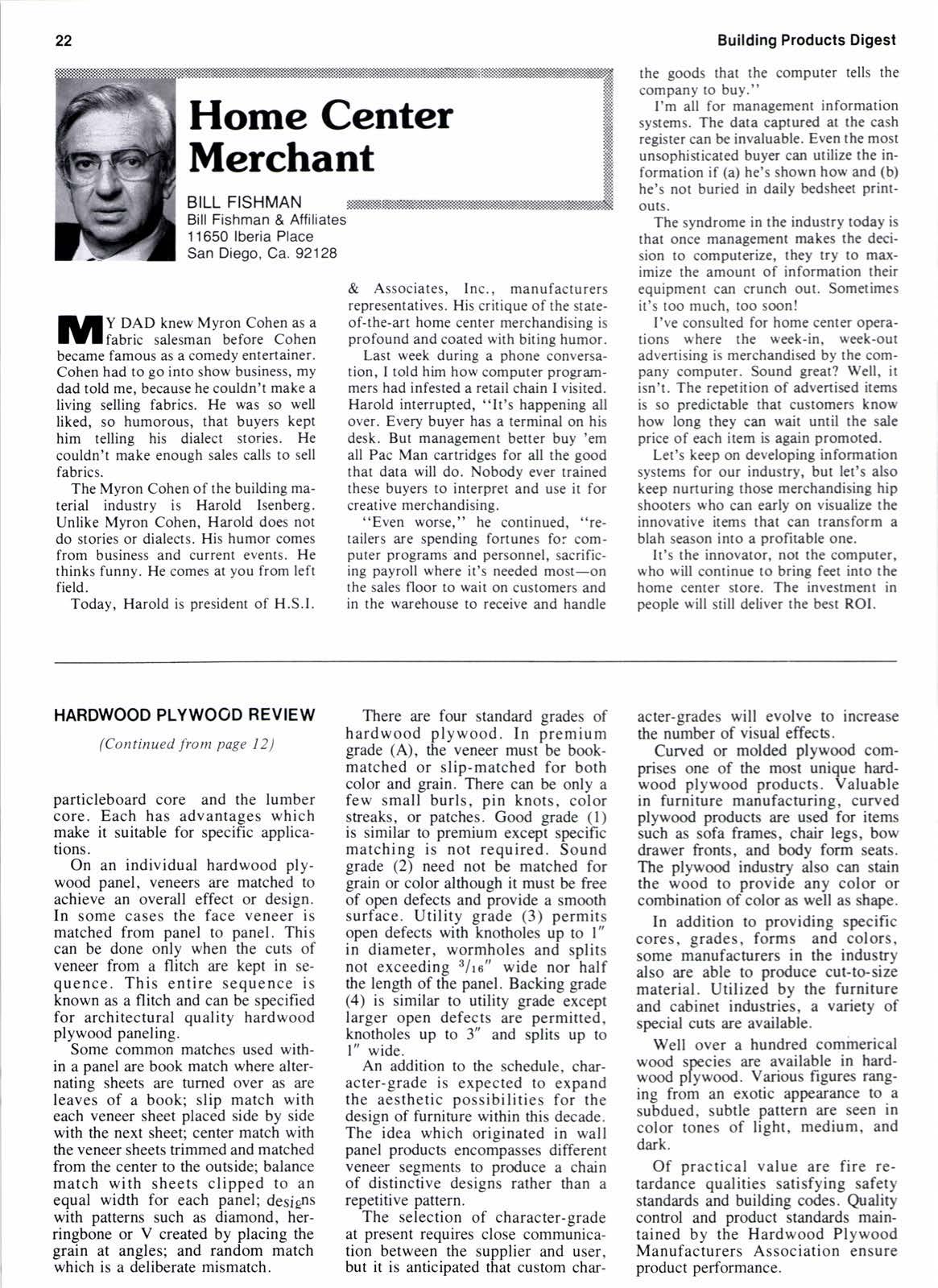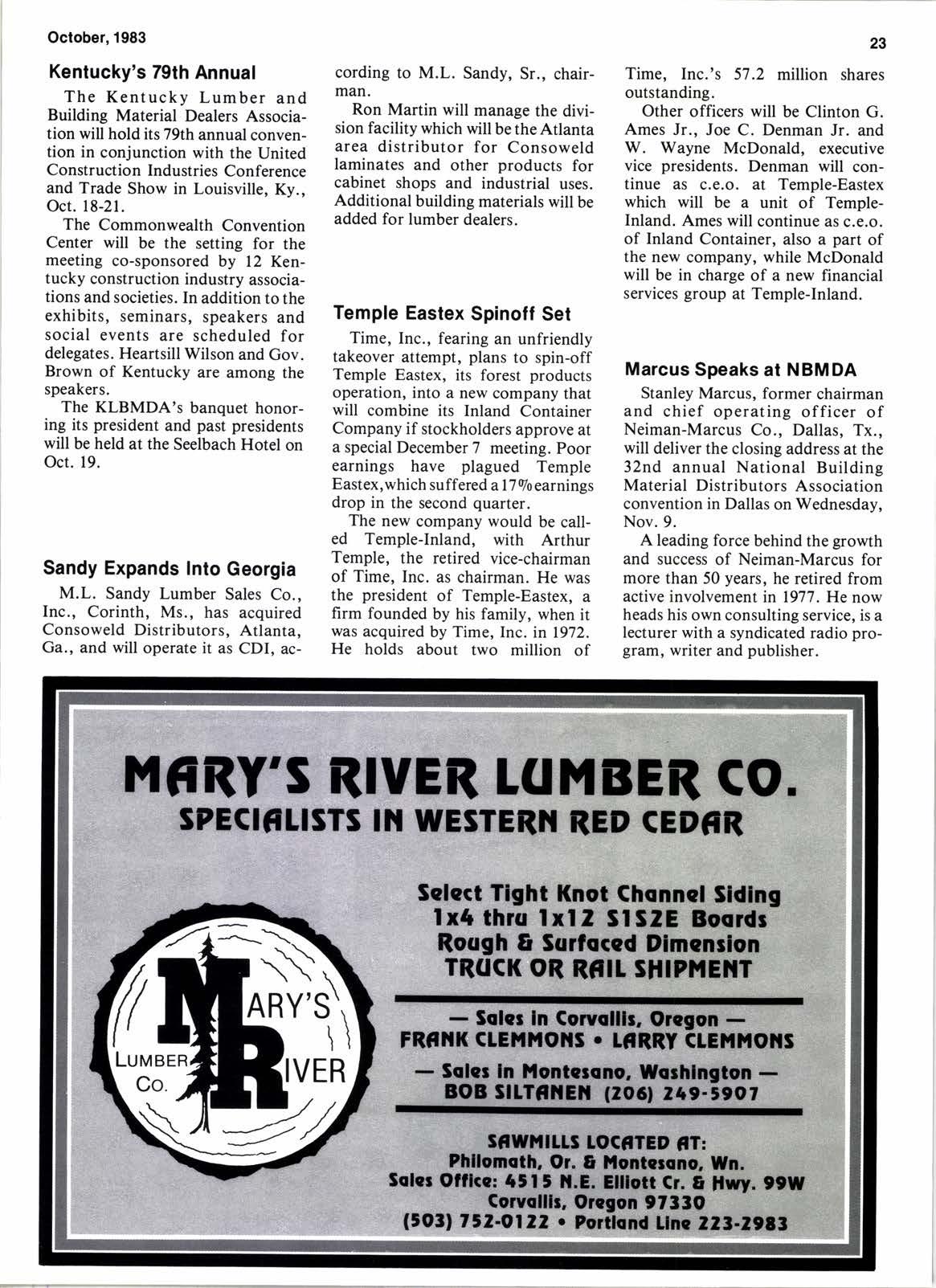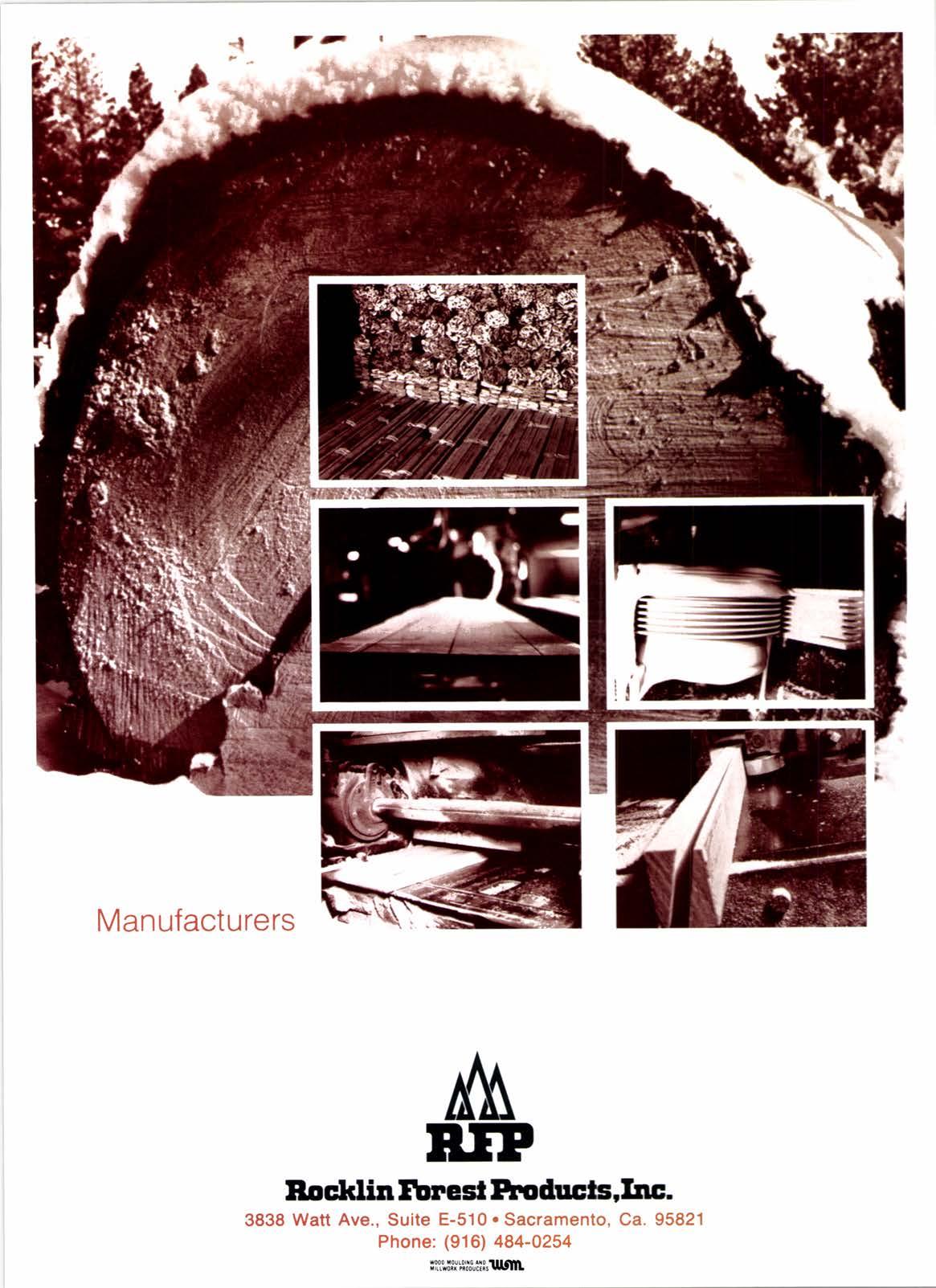
5 minute read
Home Center Merchant
Bill Fishman
Bill Fishman & Affiliates
11650 lberia Place
San Diego, Ca.92128
Y DAD knew Myron Cohen as a fabric salesman before Cohen became famous as a comedy entertainer. Cohen had to go into show business, my dad told me. because he couldn't make a living selling fabrics. He was so well liked, so humorous, that buyers kept him telling his dialect stories. He couldn't make enough sales calls to sell fabrics.
The Myron Cohen of the building material industry is Harold Isenberg. Unlike Myron Cohen, Harold does not do stories or dialects. His humor comes from business and current events. He thinks funny. He comes at you from left field.
Today, Harold is president of H.S.l.
Hardwood Plywood Review
(Continued from page 12) particleboard core and the lumber core. Each has advantages which make it suitable for specific applications.
On an individual hardwood plywood panel, veneers are matched to achieve an overall effect or design. In some cases the face veneer is matched from panel to panel. This can be done only when the cuts of veneer from a flitch are kept in sequence. This entire sequence is known as a flitch and can be specified for architectural quality hardwood plywood paneling.
Some common matches used within a panel are book match where alternating sheets are turned over as are leaves of a book; slip match with each veneer sheet placed side by side with the next sheel center match with the veneer sheets trimmed and matched from the center to the outside; balance match with sheets clipped to an equal width for each panel; desipns with patterns such as diamond, herringbone or V created by placing the grain at angles; and random match which is a deliberate mismatch.
& Associates, Inc., manufacturers representatives. His critique of the stateof-the-art home center merchandising is profound and coated with biting humor.
Last week during a phone conversation, I told him how computer programmers had infested a retail chain I visited. Harold interrupted, "It's happening all over. Every buyer has a terminal on his desk. But management better buy 'em all Pac Man cartridges for all the good that data will do. Nobody ever trained these buyers to interpret and use it for creative merchandising.
"Even worse," he continued, "retailers are spending fortunes for computer programs and personnel, sacrificing payroll where it's needed most-on the sales floor to wait on customers and in the warehouse to receive and handle the goods that the computer tells the company to buy."
I'm all for management information systems. The data captured at the cash register can be invaluable. Even the most unsophisticated buyer can utilize the information if (a) he's shown how and (b) he's not buried in daily bedsheet printouts.
The syndrome in the industry today is that once management makes the decision to computerize, they try to m:rximize the amount of information their equipment can crunch out. Sometimes it's too much, too soon!
I've consulted for home center operations where the week-in, week-out advertising is merchandised by the company computer. Sound great? Well, it isn't. The repetition of advertised items is so predictable that customers know how long they can wait until the sale price of each item is again promoted.
Let's keep on developing information systems for our industry, but let's also keep nurturing those merchandising hip shooters who can early on visualize the innovative items that can transform a blah season into a profitable one.
It's the innovator, not the computer, who will continue to bring feet into the home center store. The investment in people will still deliver the best ROl.
There are four standard grades of hardwood plywood. In premium grade (A), the veneer must be bookmatched or slip-matched for both color and grain. There can be only a few small burls, pin knots, color sFeaks, or patches. Good grade (l) is similar to premium except specific matching is not required. Sound grade (2) need not be matched for grain or color although it must be free of open defects and provide a smooth surface. Utility grade (3) permits open defects with knotholes up to l" in diameter, wormholes and splits not exceeding 3/re" wide nor half the length ofthe panel. Backing grade (4) is similar to utility grade except larger open defects are permitted, knotholes up to 3" and splits up to l" wide.
An addition to the schedule, character-grade is expected to expand the aesthetic possibilities for the design of furniture within this decade. The idea which originated in wall panel products encompasses different veneer segments to produce a chain of distinctive designs rather than a repetitive pattern.
The selection of character-grade at present requires close communication between the supplier and user, but it is anticipated that custom char- acter-grades will evolve to increase the number of visual effects.
Curved or molded plywood comprises one of the most unique hardwood plywood products. Valuable in furniture manufacturing, curved plywood products are used for items such as sofa frames, chair legs, bow drawer fronts, and body form seats. The plywood industry also can stain the wood to provide any color or combination of color as well as shape.
In addition to providing specific cores, grades, forms and colors, some manufacturers in the industry also are able to prduce cut-tesize material. Utilized by the furniture and cabinet industries, a variety of special cuts are available.
Well over a hundred cominerical wood species are available in hardwood pfywood. Various figures ranging from an exotic appearance to a subdued, subtle pattern are seen in color tones of light, medium, and dark.
Of practical value are fire retardance qualities satisfying safety standards and building codes. Qualiry conhol and product standards maintained by the Hardwood Plywood Manufacturers Association ensure product performance.
Kentucky's 79th Annual
The Kentucky Lumber and Building Material Dealers Association will hold its 79th annual convention in conjunction with the United Construction Industries Conference and Trade Show in Louisville, Ky., Oct. l8-21.
The Commonwealth Convention Center will be the setting for the meeting co-sponsored by 12 Kentucky construction industry associations and societies. In addition to the exhibits, seminars, speakers and social events are scheduled for delegates. Heartsill Wilson and Gov. Brown of Kentucky are among the speakers.
The KLBMDA's banquet honoring its president and past presidents will be held at the Seelbach Hotel on Oct. 19.
Sandy Expands Into Georgia
M.L. Sandy Lumber Sales Co., Inc., Corinth, Ms., has acquired Consoweld Distributors, Atlanta, Ga., and will operate it as CDI, ac- cording to M.L. Sandy, Sr., chairman.

Ron Martin will manage the division facility which will be the Atlanta area distributor for Consoweld laminates and other products for cabinet shops and industrial uses. Additional building materials will be added for lumber dealers.
Temple Eastex Spinoff Set
Time, Inc., fearing an unfriendly takeover attempt, plans to spin-off Temple Eastex, its forest products operation, into a new company that will combine its Inland Container Company if stockholders approve at a special December 7 meeting. Poor earnings have plagued Temple Eastex,which suffered a I 7 9o earnings drop in the second quarter.
The new company would be called Temple-Inland, with Arthur Temple, the retired vice-chairman of Time, Inc. as chairman. He was the president of Temple-Eastex, a firm founded by his family, when it was acquired by Time, lnc. in 1972. He holds about two million of
Time, Inc.'s 57.2 million shares outstanding.
Other officers will be Clinton G. Ames Jr., Joe C. Denman Jr. and W. Wayne McDonald, executive vice presidents. Denman will continue as c.e.o. at Temple-Eastex which will be a unit of TempleInland. Ames will continue as c.e.o. of Inland Container, also a part of the new company, while McDonald will be in charge of a new financial services group at Temple-Inland.
Marcus Speaks at NBMDA
Stanley Marcus, former chairman and chief operating officer of Neiman-Marcus Co., Dallas, Tx., will deliver the closing address at the 32nd annual National Building Material Distributors Association convention in Dallas on Wednesday, Nov.9.
A leading force behind the growth and success of Neiman-Marcus for more than 50 years, he retired from active involvement in 1977. He now heads his own consulting service, is a lecturer with a syndicated radio program, writer and publisher.











